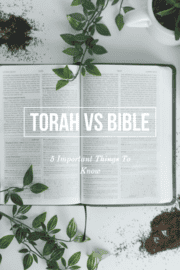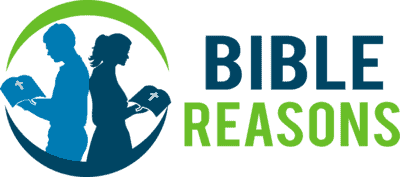Jews and Christians are known as People of the Book. This is in reference to the Bible: God’s Holy Word. But how different is the Torah from the Bible?

History
The Torah is part of the sacred Scriptures of the Jewish people. The Hebrew Bible, or Tanakh, is typically divided into three parts: the Torah, the Ketuviym (the Writings), and the Navi’im (the Prophets.) The Torah is their narrative history. It also explains how they are to worship God and conduct their lives as witnesses of Him.
The Bible is the holy book of the Christians. It is made up of two primary books filled with many smaller books. The two primary books are the New Testament and the Old Testament. The Old Testament tells the story of God revealing Himself to the Jewish people and the New Testament tells how Christ is a completion of the Old Testament.
Language
The Torah is written in Hebrew only. The Bible was originally written in Hebrew, Greek, and Aramaic.
Description of the five books of the Torah
The Torah includes the five books, as well as the oral traditions in the Talmud and the Midrash. The five books included are Genesis, Exodus, Leviticus, Numbers, and Deuteronomy. These five books were written by Moses. The Torah gives different names to these books: The Bereshiyt (In the Beginning), Shemot (Names), Vayiqra (And He Called), Bemidbar (In the Wilderness), and Devariym (Words.)
Differences and misconceptions
One major difference is that the Torah is handwritten on a scroll and is only read by a Rabbi during a ceremonial reading at specific times of the year. Whereas the Bible is printed and owned by Christians who are encouraged to study it daily.
The gospel of Jesus Christ
In Genesis, we can see that God is a Holy and Perfect God, the Creator of all things. And He demands holiness because He is perfectly Holy. All sin is enmity against God. Adam and Eve, the first people created, sinned. Their one sin was sufficient to cast them out of the Garden and to condemn them to Hell. But God made a covering for them and promised to make a way of forever cleansing them of their sin.
This same story was repeated throughout the entire Torah/Old Testament. Over and over the narrative tells the story about man’s inability to be perfect according to God’s standards, and God making a way to cover up the sins so that there could be fellowship, and an ever-present focus on the Messiah to come that would take away the sins of the world. This Messiah was prophesied about numerous times.
In Genesis we can see that the Messiah would be born of a woman. Jesus fulfilled this in Matthew and Galatians. In Micah it is said that the Messiah would be born in Bethlehem. In Matthew and Luke we are told Jesus was born in Bethlehem. In Isaiah it says the Messiah would be born of a virgin. In Mathew and Luke we can see that Jesus was. In Genesis, Numbers, 2 Samuel, and Isaiah we can see that the Messiah would be a descendant of Abraham, Isaac and Jacob, from the Tribe of Judah, and an heir to King David’s throne. This was fulfilled in Matthew, Romans, Luke, and Hebrews by Jesus.
In Isaiah and Hosea we learn that the Messiah would be called Immanuel and that He would spend a season in Egypt. Jesus did this in Matthew. In Deuteronomy, Psalms, and Isaiah, we learn that the Messiah would be a prophet and would be rejected by His own people. This happened to Jesus in John and Acts. In Psalms we see that the Messiah would be declared the Son of God and Jesus was in Matthew. In Isaiah it says that the Messiah would be called a Nazarene and that He would bring light to Galilee. Jesus did this in Matthew. In Psalms and Isaiah we see that the Messiah would speak in Parables. Jesus did this many times in Matthew.
In Psalms and Zechariah it says that the Messiah would be a priest in the order of Melchizedek, that He would be called King, that He would be praised by children and that He would be betrayed. Jesus did this in Matthew, Luke, and Hebrews. In Zechariah it says that the Messiah’s price money would be used to buy a potters field. This happened in Matthew. In Isaiah and Psalms it says that the Messiah would be falsely accused, silent before His accusers, spat upon and struck, hated without a cause and crucified with criminals. Jesus fulfilled this in Mark, Matthew and John.
In Psalms and Zechariah it says that the Messiahs hands, side, and feet would be pierced. Jesus’ were in John. In Psalm and Isaiah it says that the Messiah would pray for His enemies, that He would be buried with the rich, and that He would resurrect from the dead. Jesus did this in Luke, Matthew, and Acts. In Isaiah it says that the Messiah would be a sacrifice for sins. We learn that this was Jesus in Romans.
In the New Testament we can see Jesus. The Messiah. He came to earth. God, wrapped in flesh. He came and lived a perfect, sinless life. Then He was crucified. On the cross He bore our sins and God poured out His wrath upon His Son. He was the perfect sacrifice to take away the sins of the world. He died and three days later rose from the dead. It is by repenting of our sins and placing our faith in Jesus that we can be saved.
Conclusion
The Bible is the completion of the Torah. It is not in opposition to it. Let us read the Old Testament/Torah and marvel at the wonder that is Christ, our Messiah, the perfect sacrifice to take away the sins of the world.
